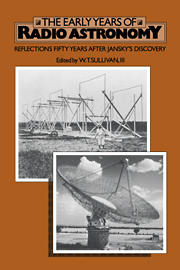Preface
Published online by Cambridge University Press: 05 March 2010
Summary
Fifty years ago Karl Jansky accidentally discovered that the Milky Way is a copious source of radio waves. This eventually led to detailed study of extraterrestrial radio waves, which for three reasons has unquestionably been one of the key developments in the astronomy of our century. First, there are of course the startling results themselves, revealing a panoply of unexpected phenomena. After radio galaxies, quasars, pulsars, the cosmic background radiation, and complex interstellar molecules, the Universe would never again be the same. Second, the style of research of the radio researchers eventually also changed the way that traditional astronomy was done; here I refer to the use of electronics and the attitude that primary training in astronomy was not necessary for success. Third, the achievements of radio astronomy provided much of the basis for the desire to scan the skies at every electromagnetic frequency possible, a program which has dominated much of subsequent observational astronomy. When an historian of the distant future characterizes the astronomy of our own era, major emphasis will surely be placed on this continual opening of the electromagnetic window and our resultant expanded view of the Universe, a process which began with radio astronomy.
It is thus both important and fitting that we pause after fifty years and collect the reflections of the pioneers of radio astronomy. To this end a score of major participants have contributed to the present volume their recollections and analyses of how the field developed. While recollection by itself is not history, these articles yield invaluable glimpses, not otherwise obtainable, of the spirit of the times, and also serve as starting points for delving further into the history.
- Type
- Chapter
- Information
- The Early Years of Radio AstronomyReflections Fifty Years after Jansky's Discovery, pp. vii - xPublisher: Cambridge University PressPrint publication year: 1984

